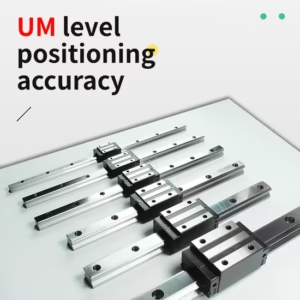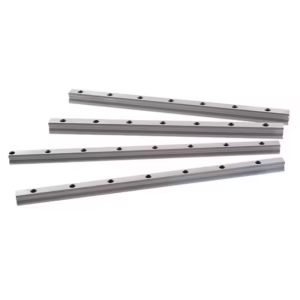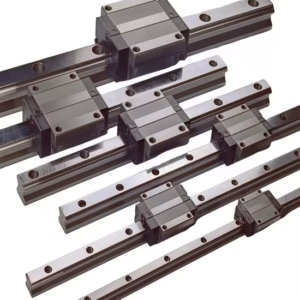| Section | Subtopics |
|---|---|
| Introduction | Definition, importance, overview of applications |
| Rail Linear | What is a rail linear system? Key elements and function |
| Evolution of Rail Linear Systems | Early linear motion methods, transition to precision rail systems |
| Types of Rail Linear Systems | Profile rail guides, round rail guides, miniature linear guides |
| Core Components of Rail Linear Systems | Rails, carriages, rolling elements, seals, lubrication |
| How Rail Linear Systems Work | Motion mechanics, load transfer, friction reduction |
| Advantages of Rail Linear Systems | High precision, rigidity, load capacity |
| Disadvantages of Rail Linear Systems | Cost, installation challenges, maintenance |
| Applications of Rail Linear in Industry | CNC machines, robotics, packaging, automotive |
| Rail Linear in Automation | Enhancing factory productivity, assembly lines |
| Rail Linear in Robotics | Robotic arms, pick-and-place systems |
| Rail Linear in Medical Devices | Imaging systems, surgical equipment |
| Rail Linear in Aerospace and Defense | Flight simulators, satellite assembly |
| Rail Linear vs Traditional Sliding Systems | Performance, accuracy, cost comparison |
| Selecting the Right Rail Linear System | Load considerations, environment, speed requirements |
| Installation Best Practices | Alignment, mounting, fastening methods |
| Maintenance of Rail Linear Systems | Cleaning, lubrication, inspection cycles |
| Common Failures in Rail Linear Systems | Wear, contamination, misalignment |
| Future Trends in Rail Linear Systems | Smart sensors, predictive maintenance |
| Sustainability in Rail Linear Manufacturing | Eco-friendly materials, energy efficiency |
| Top Rail Linear Manufacturers Worldwide | THK, HIWIN, Bosch Rexroth |
| Rail Linear in DIY and Hobby Projects | 3D printers, CNC routers |
| Rail Linear for Heavy Industry | Mining equipment, steel plants |
| Cost Factors in Rail Linear Systems | Material quality, precision grade |
| Buying Guide for Rail Linear Systems | Online stores, custom solutions |
| Rail Linear | Recap of importance and final insights |
| FAQs | At least six questions with answers |
| Conclusion | Final summary and call to action |
Introduction
Industrial automation is only as good as the motion systems behind it. Whether it’s a robotic arm picking up components or a CNC machine cutting through metal, accuracy in movement defines the quality of output. This is where rail linear systems come into play. Known for their unmatched precision, load-handling capacity, and smooth operation, rail linear guides are a cornerstone of modern engineering.
Unlike simple sliders or bushings, rail linear systems combine friction reduction, durability, and rigidity in one package. They’ve become essential in industries like aerospace, automotive, packaging, and even healthcare. Today’s high-performance factories cannot function without them. In this guide, we’ll explore what rail linear systems are, how they work, their advantages, challenges, and future trends.
Rail Linear
A rail linear system is a mechanical structure that allows objects to move in a straight line with minimal resistance. It consists of rails that serve as tracks and carriages (also called blocks) that move along them. Inside the carriage, rolling elements like balls or rollers reduce friction and allow smooth motion.
Rail linear systems are designed for precision, load capacity, and repeatability. They ensure that even under high speeds and heavy loads, the motion remains stable and accurate. This is why they are found in everything from small 3D printers to large-scale aerospace assembly lines.
Evolution of Rail Linear Systems
Before rail linear systems, engineers used plain sliding bearings, which worked but had drawbacks like high wear and energy loss. As industries demanded higher tolerances and productivity, these outdated systems couldn’t keep up.
The development of recirculating ball bearing rails changed everything. Suddenly, machines could achieve micron-level accuracy with consistent performance. Over time, innovations like profile rail guides, preloaded carriages, and self-lubricating seals pushed the boundaries even further.
Today, the integration of smart sensors and predictive maintenance software is redefining what rail linear systems can achieve.
Types of Rail Linear Systems
Profile Rail Guides
Square shape, high rigidity
Handle heavy loads
Found in CNC machines, robotic arms
Round Rail Guides
Cylindrical rails, easier to install
More forgiving in misalignment
Used in packaging and conveyor systems
Miniature Rail Guides
Compact, lightweight, highly precise
Found in medical equipment and electronics manufacturing
Each type offers unique benefits, and the selection depends on the industry’s demands.

Core Components of Rail Linear Systems
The reliability of a rail linear guide depends on the quality and alignment of its components:
Rails – Hardened, ground steel surfaces ensuring accuracy.
Carriages – Blocks that house the rolling elements.
Rolling Elements – Steel balls or cylindrical rollers that minimize friction.
Seals & Shields – Keep dust and debris out of the mechanism.
Lubrication System – Oil or grease supply for smooth, continuous operation.
How Rail Linear Systems Work
The working principle is simple yet powerful. The carriage slides along the rail, supported by circulating rolling elements. These rolling elements create a thin film of motion, reducing friction dramatically compared to sliding surfaces.
The load is evenly distributed across multiple contact points, which gives rail linear systems their stability and long life. Unlike wheels or belts, they do not slip, ensuring perfect accuracy.
Advantages of Rail Linear Systems
High precision with minimal deviation
Ability to carry both light and heavy loads
Reduced friction and wear
Long operational life
Compact design compared to traditional slides
Quiet and smooth operation
These benefits explain why rail linear guides dominate automation, robotics, and CNC machining.
Disadvantages of Rail Linear Systems
While powerful, rail linear systems aren’t without limitations:
Higher initial cost compared to basic slides
Require precision installation to avoid misalignment
Sensitive to contaminants like dust and moisture
Need regular lubrication for longevity
For high-performance industries, though, the advantages far outweigh the drawbacks.
Applications of Rail Linear in Industry
Rail linear systems are everywhere:
CNC machines – Milling, turning, and grinding require micron-level precision.
Automotive – Used in assembly lines, welding robots, and inspection equipment.
Electronics – Enable fine placement in circuit board production.
Packaging – Smooth motion ensures speed and reliability.
Logistics – Automated warehouses rely on rail linear tracks.
Rail Linear in Automation
Automation thrives on repeatable precision. Rail linear guides make this possible by enabling machines to work at high speeds without losing accuracy. In production lines, they ensure smooth transitions and consistent product quality.
Companies adopting Industry 4.0 are integrating rail linear systems with smart controls, leading to higher productivity and reduced downtime.
Rail Linear in Robotics
Robots depend on rail linear systems to move arms, grippers, and sensors with accuracy. In assembly lines, pick-and-place robots equipped with rail linear guides can handle thousands of cycles per hour.
In collaborative robots (cobots), rail linear ensures safe and precise human-machine interaction.
Rail Linear in Medical Devices
Healthcare requires ultra-precise equipment. Rail linear systems power:
MRI and CT scanners
Robotic surgery tools
Laboratory automation systems
Miniature rail guides help doctors and researchers achieve life-saving precision.
Rail Linear in Aerospace and Defense
In aerospace, accuracy is mission-critical. Rail linear guides are used in:
Aircraft assembly
Satellite manufacturing
Flight simulators
Their high rigidity ensures stability under extreme conditions.
Rail Linear vs Traditional Sliding Systems
| Feature | Rail Linear | Sliding Systems |
|---|---|---|
| Precision | Very high | Moderate |
| Load Capacity | High | Medium |
| Friction | Very low | High |
| Cost | Higher | Lower |
| Durability | Long life | Shorter life |
Clearly, rail linear outperforms traditional systems in most categories.
Selecting the Right Rail Linear System
Consider these factors before buying:
Load requirements
Operating speed
Environmental conditions (dust, moisture, temperature)
Budget
Space constraints
Installation Best Practices
For optimal performance:
Ensure perfect alignment of rails
Use proper mounting surfaces
Follow manufacturer’s torque specifications
Test movement before full operation
Maintenance of Rail Linear Systems
Preventive maintenance keeps systems running longer. Key practices include:
Regular lubrication
Cleaning to remove debris
Visual inspection for wear
Replacing seals when worn
Common Failures in Rail Linear Systems
Wear from contamination
Misalignment leading to uneven loads
Lubrication failure causing friction
Excessive vibration damaging components
Future Trends in Rail Linear Systems
Tomorrow’s rail linear technology will feature:
Smart sensors for monitoring wear
Self-lubricating materials
Predictive maintenance using AI
Lightweight composite rails for efficiency
Sustainability in Rail Linear Manufacturing
Eco-conscious industries demand:
Recyclable materials
Energy-efficient production methods
Longer lifespan components reducing waste
Top Rail Linear Manufacturers Worldwide
THK – Japan
HIWIN – Taiwan
Bosch Rexroth – Germany
NSK Motion Solutions – Japan
SKF – Sweden
Rail Linear in DIY and Hobby Projects
Hobbyists use rail linear systems in:
3D printers
Laser cutters
CNC routers
These affordable guides make maker projects more precise and professional.
Rail Linear for Heavy Industry
Mining, steel plants, and construction equipment rely on heavy-duty rail linear systems. They withstand extreme loads, dust, and vibrations.
Cost Factors in Rail Linear Systems
Prices vary depending on:
Material quality
Precision grade
Load rating
Manufacturer reputation
Investing in higher-quality rails often means lower long-term costs.
Buying Guide for Rail Linear Systems
Best options include:
Industrial suppliers like RS Components, McMaster-Carr
Manufacturer-direct purchases
Custom orders for unique projects
Rail Linear
In summary, a rail linear guide is more than a machine part—it’s a backbone of precision motion. Industries rely on it for automation, robotics, aerospace, healthcare, and even DIY projects. With continuous innovation, rail linear systems will only become smarter, greener, and more indispensable.
FAQs
What is a rail linear guide used for?
It ensures precise straight-line motion in machines like CNC, robots, and medical equipment.
How long do rail linear systems last?
With proper lubrication and care, they can last for tens of thousands of operational hours.
Are rail linear systems expensive?
They are costlier than basic sliding systems but save money long-term through durability.
Which is better: profile rail or round rail?
Profile rails provide higher precision and rigidity, while round rails are more forgiving in alignment.
Do rail linear systems need lubrication?
Yes, lubrication is essential to reduce wear and extend service life.
Can rail linear guides be used outdoors?
Yes, but they require corrosion-resistant coatings and protective seals.
Conclusion
Rail linear systems are the unsung heroes of automation and precision engineering. Their ability to combine accuracy, durability, and versatility makes them essential across industries. From robotics to aerospace, they provide the backbone for smooth, repeatable motion.
As industries evolve, we’ll see even smarter, more sustainable rail linear systems powering the future. Whether you’re a manufacturer, engineer, or hobbyist, understanding rail linear technology is key to unlocking efficiency and precision.




